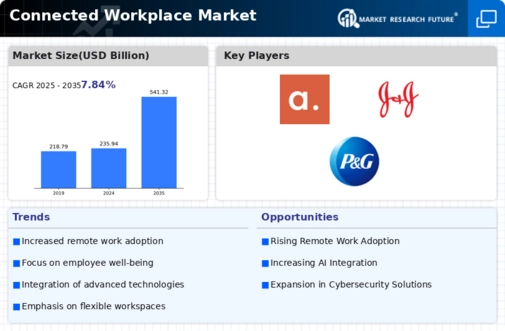Rise of Remote Work Solutions
The increasing adoption of remote work solutions is a primary driver for the connected workplace market. As organizations in the US embrace flexible work arrangements, the demand for technologies that facilitate remote collaboration and communication has surged. According to recent data, approximately 30% of the US workforce is now engaged in remote work, necessitating robust digital infrastructure. This shift compels companies to invest in connected workplace solutions that enhance productivity and connectivity among dispersed teams. The connected workplace market is expected to grow significantly as businesses seek to implement tools that support seamless interaction, project management, and virtual meetings, thereby fostering a cohesive work environment regardless of physical location.
Advancements in IoT Technologies
The rapid advancements in Internet of Things (IoT) technologies are significantly influencing the connected workplace market. IoT devices, such as smart sensors and connected equipment, are being integrated into workplace environments to optimize operations and enhance employee experiences. In the US, the IoT market is expected to grow to $1 trillion by 2025, indicating a robust demand for interconnected devices that facilitate real-time data collection and analysis. This integration allows organizations to monitor workplace conditions, manage resources efficiently, and improve overall productivity. As businesses recognize the potential of IoT in creating smarter workplaces, the connected workplace market is likely to expand, driven by the need for innovative solutions that support operational excellence.
Emphasis on Cybersecurity Measures
In an era where data breaches and cyber threats are prevalent, the emphasis on cybersecurity measures is a crucial driver for the connected workplace market. Organizations in the US are increasingly prioritizing the protection of sensitive information, leading to heightened investments in secure communication platforms and data management systems. The market for cybersecurity solutions is projected to reach $300 Billion by 2025, reflecting the urgency for businesses to safeguard their digital assets. This focus on security not only enhances trust among employees and clients but also ensures compliance with regulatory standards. Consequently, the connected workplace market is evolving to incorporate advanced security features, making it a vital component of modern organizational strategies.
Growing Demand for Flexible Workspaces
The growing demand for flexible workspaces is reshaping the connected workplace market. As organizations in the US seek to adapt to changing employee preferences, the design of work environments is evolving to accommodate collaborative and dynamic work styles. Research indicates that 70% of employees prefer flexible work arrangements, prompting companies to invest in technologies that support agile workspace management. This trend includes the implementation of smart office solutions that allow for real-time booking of meeting rooms and collaborative spaces. The connected workplace market is thus positioned to thrive as businesses prioritize the creation of adaptable environments that enhance employee satisfaction and productivity.
Increased Focus on Employee Engagement
An increased focus on employee engagement is driving the connected workplace market forward. Organizations in the US are recognizing the importance of fostering a positive workplace culture to enhance productivity and retention rates. Studies show that engaged employees are 17% more productive, prompting companies to invest in tools that facilitate communication and collaboration. The connected workplace market is responding by offering solutions that promote transparency, feedback, and recognition among teams. By leveraging technology to enhance employee engagement, organizations can create a more motivated workforce, which in turn contributes to overall business success. This trend indicates a shift towards a more holistic approach to workplace management.

















Leave a Comment